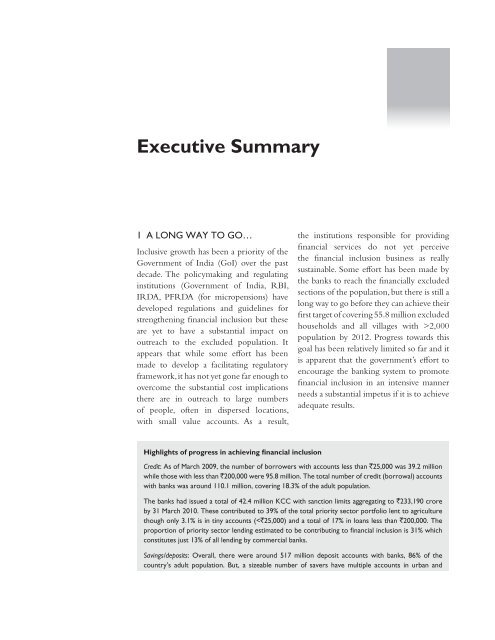Promoting Financial Inclusion - United Nations Development ...
Promoting Financial Inclusion - United Nations Development ...
Promoting Financial Inclusion - United Nations Development ...
Create successful ePaper yourself
Turn your PDF publications into a flip-book with our unique Google optimized e-Paper software.
Executive Summary<br />
1 A LONG WAY TO GO…<br />
Inclusive growth has been a priority of the<br />
Government of India (GoI) over the past<br />
decade. The policymaking and regulating<br />
institutions (Government of India, RBI,<br />
IRDA, PFRDA (for micropensions) have<br />
developed regulations and guidelines for<br />
strengthening financial inclusion but these<br />
are yet to have a substantial impact on<br />
outreach to the excluded population. It<br />
appears that while some effort has been<br />
made to develop a facilitating regulatory<br />
framework, it has not yet gone far enough to<br />
overcome the substantial cost implications<br />
there are in outreach to large numbers<br />
of people, often in dispersed locations,<br />
with small value accounts. As a result,<br />
the institutions responsible for providing<br />
financial services do not yet perceive<br />
the financial inclusion business as really<br />
sustainable. Some effort has been made by<br />
the banks to reach the financially excluded<br />
sections of the population, but there is still a<br />
long way to go before they can achieve their<br />
first target of covering 55.8 million excluded<br />
households and all villages with >2,000<br />
population by 2012. Progress towards this<br />
goal has been relatively limited so far and it<br />
is apparent that the government’s effort to<br />
encourage the banking system to promote<br />
financial inclusion in an intensive manner<br />
needs a substantial impetus if it is to achieve<br />
adequate results.<br />
Highlights of progress in achieving financial inclusion<br />
Credit: As of March 2009, the number of borrowers with accounts less than `25,000 was 39.2 million<br />
while those with less than `200,000 were 95.8 million. The total number of credit (borrowal) accounts<br />
with banks was around 110.1 million, covering 18.3% of the adult population.<br />
The banks had issued a total of 42.4 million KCC with sanction limits aggregating to `233,190 crore<br />
by 31 March 2010. These contributed to 39% of the total priority sector portfolio lent to agriculture<br />
though only 3.1% is in tiny accounts (

















